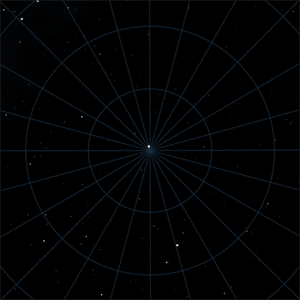 The Earth rotates counter clockwise with a period of almost one day. This corresponds to an angular velocity of about 0.25° per minute (360° per day). As a result, all celestial bodies (not counting meteors and satellites) appear to be moving counter clockwise across the northern sky at this rate. The star Polaris lies only 0.7° away from the pole of rotation and is therefore also called the Northern Star. All the other stars appear to circle around it.
The Earth rotates counter clockwise with a period of almost one day. This corresponds to an angular velocity of about 0.25° per minute (360° per day). As a result, all celestial bodies (not counting meteors and satellites) appear to be moving counter clockwise across the northern sky at this rate. The star Polaris lies only 0.7° away from the pole of rotation and is therefore also called the Northern Star. All the other stars appear to circle around it.
Although the rotation can give rise to some beautiful star trail images, it is generally pretty inconvenient that the object you want to photograph is moving. This is where mounts come in handy.
A mount is a mechanical structure which supports a camera (or telescope) and allows the user to point it at the object of interest. Basically there exists two types of mounts, alt-az and equatorial. The alt-az mount has two axes of rotation: up and down (altitude) and from side to side (azimuth). It is straightforward to use and favoured by many astronomers, but for astrophotography it is useless. Although it can easily follow an object across the sky, the field of view will rotate around its center.

Alt-az (left) and equatorial (right) mounts. Notice how the object rotates with respect to the alt-az mounted telescope only.
The equatorial mount also has two axes of rotation: one that points at the north pole (pole axis), and one that is perpendicular to this (declination axis). The pole axis enables the camera to rotate along with the stars, and with the help of the declination axis you can point the camera at any point in the sky. Once you have found your object you only need to turn the polar axis to track it. This mount is perfect for astrophotography.
Unfortunately an equatorial mount is as expensive as it is desirable and I cannot afford one just yet. I am really impatient for being able to take longer exposures though, so I have found a cheap and simple alternative: the barn door tracker.